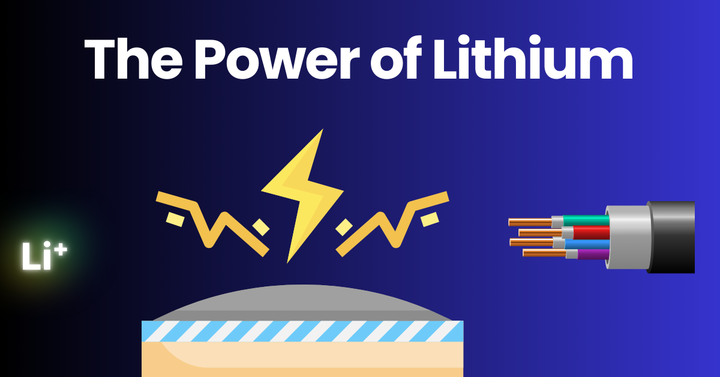Lithium | The Metal Powering the Future
Corps
Lithium is a metal that has become crucial to modern technology and innovation. From powering our smartphones to driving electric vehicles, Lithium is at the heart of numerous advancements. Its unique properties have made it the go-to material for energy storage and various other applications. This article explores everything you need to know about Lithium—its history, uses, benefits, and the future potential it holds.
The History and Discovery of Lithium
Lithium was discovered in 1817 by the Swedish chemist Johan August Arfvedson while he was analyzing the mineral petalite. This metal was named after the Greek word "lithos," meaning stone, as it was first found in mineral form rather than in a plant or animal. It wasn't until 1855 that Lithium was isolated by British chemists Augustus Matthiessen and Robert Bunsen. Since then, Lithium has evolved from being a curious chemical element to becoming one of the most important materials in the world.
What Makes Lithium Unique?
Lithium is the lightest metal and the least dense solid element. These characteristics make it ideal for applications where weight and size are critical, such as in batteries. It is highly reactive and has a high electrochemical potential, which means it can store a lot of energy. This unique ability to store and release energy efficiently is what makes Lithium indispensable in battery technology.
Unlike many other metals, Lithium can be alloyed with other metals to create lightweight, strong materials. These alloys are used in various industries, from aerospace to manufacturing. Lithium also has applications in medicine, particularly in the treatment of bipolar disorder, where Lithium salts are used as mood stabilizers.
Lithium in Batteries: Powering the Modern World
Perhaps the most well-known application of Lithium is in batteries. Lithium-ion batteries are the most common type of rechargeable batteries found in modern electronics, from smartphones and laptops to electric vehicles. These batteries have revolutionized the way we store and use energy.
Lithium-ion batteries are preferred because they are lightweight, have a high energy density, and have a low self-discharge rate. This means they can hold a charge for a long time without losing much power. Additionally, these batteries have a long lifespan, which makes them cost-effective in the long run.
The demand for Lithium has surged in recent years due to the increasing adoption of electric vehicles (EVs). EVs rely heavily on Lithium-ion batteries for their power, and as more people switch to electric cars, the demand for Lithium continues to grow.
The Process of Extracting Lithium
The extraction of Lithium is a complex process that varies depending on the source of the metal. There are two main sources of Lithium: brine pools and hard rock mines.
Brine Pools: The majority of Lithium is extracted from brine pools, which are found in salt flats. The process involves pumping Lithium-rich brine to the surface and allowing it to evaporate. The remaining solution is then processed to extract Lithium. This method is more environmentally friendly compared to hard rock mining, but it is slower and requires large amounts of water.
Hard Rock Mining: Lithium can also be extracted from spodumene, a mineral found in hard rock deposits. This method involves crushing the rock and then using chemical processes to extract the Lithium. Hard rock mining is faster but has a greater environmental impact due to the use of chemicals and the disruption of the landscape.
Lithium and the Environment: A Double-Edged Sword
While Lithium is essential for the development of clean energy technologies, its extraction and use come with environmental challenges. The extraction process, particularly from brine pools, requires large amounts of water, which can be a scarce resource in the regions where Lithium is often found, such as South America's "Lithium Triangle" (Bolivia, Argentina, and Chile). This has led to concerns about water depletion and the impact on local communities.
Moreover, the production and disposal of Lithium-ion batteries pose environmental risks. If not properly managed, the chemicals in these batteries can leach into the soil and water, causing pollution. Recycling Lithium batteries is crucial to mitigate these risks, but the process is currently expensive and not widely practiced.
The Future of Lithium: Beyond Batteries
The future of Lithium extends beyond just batteries. Researchers are exploring new applications for this versatile metal, such as in the development of high-performance ceramics and as a potential fuel for nuclear fusion—a process that could provide a nearly limitless supply of clean energy.
In the medical field, Lithium continues to be an important treatment for bipolar disorder. New studies are investigating its potential use in other areas of mental health and even in the treatment of neurodegenerative diseases like Alzheimer's.
Global Demand and Supply: The Race for Lithium
As the world shifts towards renewable energy and electric vehicles, the demand for Lithium is expected to skyrocket. This has led to a "Lithium rush," with countries and companies racing to secure Lithium supplies. Australia, Chile, and China are currently the leading producers of Lithium, but new sources are being explored worldwide.
The supply of Lithium is not infinite, and there are concerns about the sustainability of Lithium extraction. Companies are investing in new technologies to improve the efficiency of Lithium extraction and reduce its environmental impact. Additionally, efforts are being made to develop alternative materials for batteries that could reduce our reliance on Lithium.
Lithium Alternatives: What Could Replace Lithium?
While Lithium remains the best option for batteries today, researchers are exploring alternatives. Sodium-ion batteries, for example, are gaining attention as a potential competitor to Lithium-ion batteries. Sodium is more abundant and less expensive than Lithium, but sodium-ion batteries currently have lower energy densities and shorter lifespans. However, advancements in technology may soon close this gap.
Solid-state batteries are another promising alternative. These batteries use a solid electrolyte instead of a liquid one, which can make them safer and more efficient. Lithium is still used in solid-state batteries, but in smaller quantities. The development of these batteries could extend the lifespan of Lithium resources while providing better performance.
Investment and Market Trends in Lithium
The surge in demand for Lithium has made it a hot commodity in the investment world. Companies involved in Lithium extraction, processing, and battery production have seen significant growth. Investors are keeping a close eye on Lithium stocks, as the metal is seen as a key driver of the green energy revolution.
However, the Lithium market is also subject to volatility. Prices can fluctuate based on supply and demand, geopolitical factors, and technological advancements. As the market matures, investors are likely to see both risks and opportunities in the Lithium sector.
The Role of Lithium in the Green Energy Revolution
Lithium is not just a metal; it is a catalyst for change in the global energy landscape. The push towards renewable energy and electric transportation would not be possible without Lithium. As the world grapples with climate change, Lithium is playing a crucial role in reducing our reliance on fossil fuels and lowering greenhouse gas emissions.
The development of Lithium-ion batteries has enabled the widespread adoption of solar and wind energy by providing a reliable way to store energy. This has made renewable energy more viable and has helped reduce the carbon footprint of many industries.
Conclusion
In conclusion, Lithium is a metal that has changed the world and will continue to do so. Its unique properties make it indispensable in modern technology, particularly in energy storage. While there are challenges associated with its extraction and use, the potential benefits of Lithium far outweigh the risks.
As we move towards a more sustainable future, Lithium will remain at the forefront of innovation. From powering electric vehicles to enabling the green energy revolution, Lithium is truly the metal of the future.






commentaires